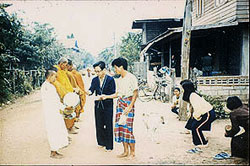3. The Choice of Northeast Thailand I chose Northeast Thailand as the study area of this project. Actually, I personally have a long history of involvement there. It was in August 1983, when I was still a first year student in my doctoral course, that I first set foot in Northeast Thailand. At the time, an interdisciplinary rural study was under way at an agricultural village in the region, led by researchers at the Center for Southeast Asian Studies, and I traveled to Northeast Thailand to join it. When I started spending time in the village, I had little knowledge about the area, let alone the Thai and Lao languages. Every day, I walked through paddy fields to observe rice growth, with a bamboo stick in my hand and a dog by my side. Since then, I have visited paddy fields, upland fields and forests in numerous villages in Northeast Thailand, and listened to village heads and villagers. Based on these experiences, I studied and published research reports on such matters as the process of land clearing for paddy and upland fields, cultivation methods and techniques, changes in community forests, employment structure of farming families, and the impact of economic development.
KONO Yasuyuki |
